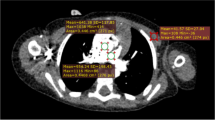Abstract
Background
Cardiac MRI has become a clinically useful supplement to ECHO and conventional X-ray angiography in the diagnostic work-up of patients with congenital heart disease (CHD). Three-dimensional (3D) sequences are capable of depicting both intracardiac and extracardiac structures with high accuracy in adults and adolescents. However, diagnostic image quality in infants and young children has not yet been reported.
Objective
To apply an optimized 3D steady-state free-precession (SSFP) MR sequence in infants and children with CHD.
Materials and methods
In 20 patients (median age 1.8 years; ten male) with CHD, whole-chest imaging was performed with navigator-gated, isotropic 3D SSFP MRI at 1.5 T. Sequence parameters were adapted to special requirements in infancy. Measurements of intra- and extracardiac structures were performed by two independent observers and compared to spin-echo and cine gradient-recalled-echo sequences.
Results
Diagnostic image quality was achieved with the 3D SSFP technique in all patients, allowing the establishment of a diagnosis in all cases. Interobserver comparison of measurements from reformatted 3D SSFP datasets revealed only minor differences with standard deviations ranging from 0.3–1.3 mm for intracardiac and 0.3–0.7 mm for extracardiac anatomy (P = ns).
Conclusion
Isotropic 3D SSFP MRI allows reliable and accurate assessment of CHD, even in free-breathing infants and young children.


Similar content being viewed by others
References
Fletcher BD, Jacobstein MD (1986) MRI of congenital abnormalities of the great arteries. AJR 146:941–948
Geva T, Kreutzer J (2001) Diagnostic pathways for evaluation of congenital heart disease. In: Crawford MH, DiMarco JP (eds) Cardiology. Mosby International, London, pp 1–22
Vitiello R, McCrindle BW, Nykanen D, et al (1998) Complications associated with pediatric cardiac catheterization. J Am Coll Cardiol 32:1433–1440
Boxt LM, Rozenshtein A (2003) MR imaging of congenital heart disease. Magn Reson Imaging Clin N Am 11:27–48
Geva T, Vick GW, Wendt RE, et al (1994) Role of spin echo and cine magnetic resonance imaging in presurgical planning of heterotaxy syndrome. Comparison with echocardiography and catheterization. Circulation 90:348–356
Chung T (2005) Magnetic resonance angiography of the body in pediatric patients: experience with a contrast-enhanced time resolved technique. Pediatr Radiol 35:3–10
Beerbaum P, Korperich H, Esdorn H, et al (2003) Atrial septal defects in pediatric patients: noninvasive sizing with cardiovascular MR imaging. Radiology 228:361–369
Glockner JF, Johnston DL, McGee KP (2003) Evaluation of cardiac valvular disease with MR imaging: qualitative and quantitative techniques. Radiographics 23:e9
Holmqvist C, Stahlberg F, Hanseus K, et al (2002) Collateral flow in coarctation of the aorta with magnetic resonance velocity mapping: correlation to morphological imaging of collateral vessels. J Magn Reson Imaging 15:39–46
Geva T, Greil GF, Marshall AC, et al (2002) Gadolinium-enhanced 3-dimensional magnetic resonance angiography of pulmonary blood supply in patients with complex pulmonary stenosis or atresia: comparison with x-ray angiography. Circulation 106:473–478
Greil GF, Powell AJ, Gildein HP, et al (2002) Gadolinium-enhanced three-dimensional magnetic resonance angiography of pulmonary and systemic venous anomalies. J Am Coll Cardiol 39:335–341
Weber OM, Martin AJ, Higgins CB (2003) Whole-heart steady-state free precession coronary artery magnetic resonance angiography. Magn Reson Med 50:1223–1228
Razavi RS, Hill DL, Muthurangu V, et al (2003) Three-dimensional magnetic resonance imaging of congenital cardiac anomalies. Cardiol Young 13:461–465
Sorensen TS, Körperich H, Greil GF, et al (2004) Operator-independent isotropic three-dimensional magnetic resonance imaging for morphology in congenital heart disease: a validation study. Circulation 110:163–169
Martirosian P, Fenchel M, Greil GF, et al (2005) Blood-myocardial contrast optimization in 3D True-FISP cardiac imaging at 1.5 T. Proceedings of the 13th Annual Meeting of the International Society of Magnetic Resonance in Medicine, Miami, p 1671
Brittain JH, Hu BS, Wright GA, et al (1995) Coronary angiography with magnetization-prepared T2 contrast. Magn Reson Med 33:689–696
Deimling M, Heid O (1994) Magnetization prepared True FISP imaging. Proceedings of the Second Annual Meeting of the Society of Magnetic Resonance, San Francisco, p 495
Botnar RM, Stuber M, Danias PG, et al (1999) Improved coronary artery definition with T2 weighted, free-breathing, three dimensional coronary MRA. Circulation 99:3139–3148
Van Praagh R (1992) Segmental approach to diagnosis. In: Fyler DC (ed) Nadas’ pediatric cardiology. Hanley & Belfus, Philadelphia, pp 27–35
Nehrke K, Bornert P, Mazurkewitz P, et al (2006) Free-breathing whole-heart coronary MR angiography on a clinical scanner in four minutes. J Magn Reson Imaging 23:752–756
Godart F, Labrot G, Devos P, et al (2002) Coarctation of the aorta: comparison of aortic dimensions between conventional MR imaging, 3D MR angiography, and conventional angiography. Eur Radiol 12:2034–2039
Park J, Larson AC, Zhang Q, et al (2005) 4D radial coronary artery imaging within a single breath-hold: cine angiography with phase-sensitive fat suppression (CAPS). Magn Reson Med 54:833–840
Didier D, Ratib O, Beghetti M, et al (1999) Morphologic and functional evaluation of congenital heart disease by magnetic resonance imaging. J Magn Reson Imaging 10:639–655
Chung T (2000) Assessment of cardiovascular anatomy in patients with congenital heart disease by magnetic resonance imaging. Pediatr Cardiol 21:18–26
Beerbaum P, Korperich H, Gieseke J, et al (2003) Rapid left-to-right shunt quantification in children by phase-contrast magnetic resonance imaging combined with sensitivity encoding (SENSE). Circulation 108:1355–1361
Acknowledgments
We thank the “EHLKE” foundation and the “Stiftung zur Förderung der Erforschung von Zivilisationserkrankungen”, Baden-Baden, Germany, for financial support and Vital Images Corporation (Plymouth, Minn.) for technical assistance.
Author information
Authors and Affiliations
Corresponding author
Rights and permissions
About this article
Cite this article
Fenchel, M., Greil, G.F., Martirosian, P. et al. Three-dimensional morphological magnetic resonance imaging in infants and children with congenital heart disease. Pediatr Radiol 36, 1265–1272 (2006). https://doi.org/10.1007/s00247-006-0314-z
Received:
Revised:
Accepted:
Published:
Issue Date:
DOI: https://doi.org/10.1007/s00247-006-0314-z




